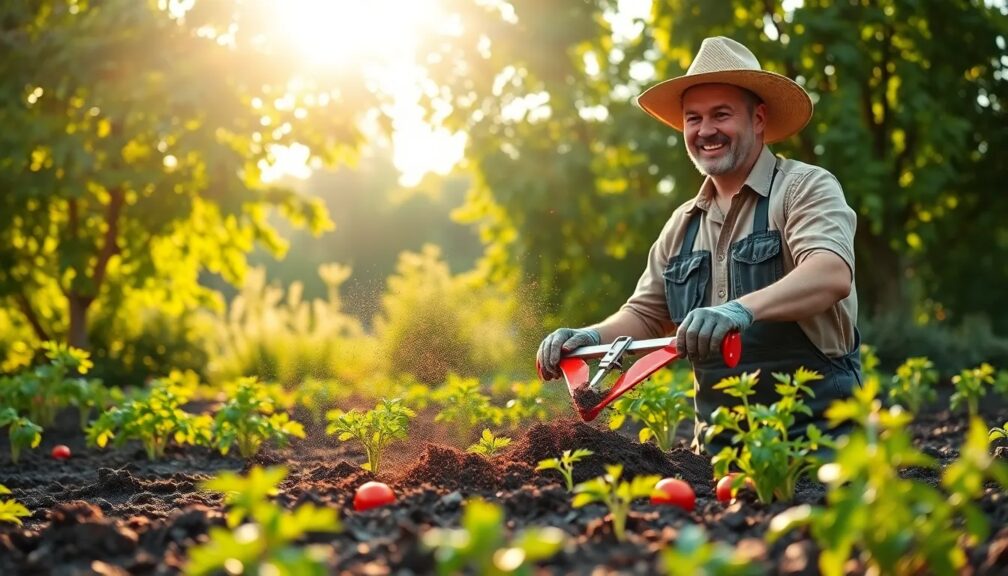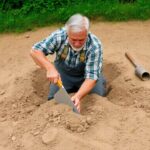Can you till a garden with a cultivator

Welcome to Our In-Depth Look at Tilling a Garden with a Cultivator
Gardening enthusiasts often ponder the best methods to prepare their soil for a bountiful season. One question that frequently surfaces is whether a cultivator can be used for tilling a garden. This article delves into the nuances of garden preparation, contrasting the use of traditional tillers with the more lightweight cultivators. By understanding the capabilities and limitations of a cultivator, gardeners can make informed decisions on how to effectively turn their soil, ensuring an optimal bed for planting. Whether you're dealing with a small vegetable patch or a larger garden landscape, the insights provided here will guide you through the process of choosing the right tool for your tilling needs.
Can you use a cultivator to till?
The question burns in the mind of every gardening enthusiast and homesteader looking to prepare their soil for the upcoming season. Discovering the right tool for tilling the earth can mean the difference between a bountiful harvest and a disappointing yield. But what if I told you that a simple cultivator, often overlooked, might just be the secret weapon in your gardening arsenal?
As the sun peeks over the horizon and the scent of fresh earth fills the air, imagine wielding a tool that not only breaks up the soil with precision but also offers a level of versatility that could transform your gardening experience. The truth is, while cultivators are primarily designed for stirring and aerating the soil, many gardeners have harnessed their power to effectively till smaller plots of land.
Imagine the satisfaction of pushing your cultivator through the earth, the tines ripping through clumps and weeds, clearing the way for seeds and nutrients to mingle with the soil. This is not just about tilling; it's about creating an environment where your plants can thrive and flourish.
But hold on; before you rush out to put this theory to the test, there's more you need to know. The effectiveness of a cultivator for tilling depends on several factors:
1. Soil Condition: Is your soil already relatively loose and free of large debris?
2. Cultivator Type: Do you have a powered cultivator or a manual one?
3. Garden Size: Are you working with raised beds, a small garden patch, or a larger plot?
Each of these points plays a crucial role in determining whether your cultivator can step up to the challenge. By understanding the capabilities and limitations of your equipment, you can avoid the disappointment of inadequate preparation and ensure that your soil is primed for planting.
Stay tuned as we delve deeper into the world of cultivators and tilling, uncovering tips, tricks, and techniques that will elevate your gardening game to new heights. Don't let this opportunity to revolutionize your garden slip through your fingers. The key to unlocking the full potential of your cultivator lies just around the corner, and we're here to guide you every step of the way.
What is the difference between a garden tiller and a garden cultivator?
Imagine stepping into your garden, a canvas of soil waiting for the magic touch of your green thumb. But hold that thought – before you can transform this slice of earth into a vibrant bed of blossoms and bounty, you must know the secret tools of the trade: the garden tiller and the garden cultivator. These are not mere tools; they are the unsung heroes that prepare your stage for the grand performance of nature.
To the untrained eye, tillers and cultivators may seem interchangeable, but the seasoned gardener knows that each serves a unique and crucial role in the art of gardening. Let’s embark on a journey of discovery to unveil their distinct functions and why choosing the right one could mean the difference between a flourishing garden and a faltering patch of land.
Garden tillers are the powerhouses, the robust warriors of soil preparation. They're designed to break new ground, tear through tough terrain, and churn compacted earth into a loose, fertile bed ready for planting. With their sharp, sturdy tines and powerful engines, tillers can cut deeply into the soil, incorporating amendments and setting the stage for aeration and drainage – elements vital to plant health and vigor.
On the flip side, garden cultivators take on a gentler, yet equally pivotal role. Like a skilled artist adding delicate touches to a masterpiece, cultivators refine and maintain the soil. They weed, mix, and aerate the top layers of your garden bed, promoting oxygen and water flow to plant roots. Cultivators are the go-to tool for the lighter task of fluffing up the soil, helping your plants to breathe and absorb nutrients more efficiently.
The choice between these two can determine the ultimate success of your garden. But that's not all – there's a compelling twist to this tale. The secret nuances of when and how to use these tools can elevate your gardening game to new heights. Are you ready to discover the untapped potential lying in your backyard? The journey into the heart of your garden begins with understanding the difference between a tiller and a cultivator – and that's a story too captivating to miss.
Can you use a cultivator to level ground?
Ah, the age-old question for gardeners and landscapers alike: the quest for the perfect, level ground. Imagine the lush, even lawns and the seamless integration of flower beds, all achieved with minimal effort. But how does one achieve this horticultural nirvana? The answer might just be hiding in plain sight within your garden shed.
While a cultivator is primarily designed for breaking up soil and weeding, its powerful tines are surprisingly adept at tackling uneven terrain. But before you set out to conquer those unruly patches of earth, let's delve into the lesser-known capabilities of this versatile tool.
1. Loosening soil: A cultivator's main function can inadvertently assist in leveling. By loosening the soil, you create a more pliable canvas to work with.
2. Clearing debris: As you cultivate, rocks, roots, and other obstructions are brought to the surface and can be removed, naturally smoothing out the surface.
3. Minor adjustments: For small dips and bumps, a cultivator may be just what you need to make those subtle shifts in the soil.
But wait, there's a catch! Before you rush out to your garden, it's crucial to know that while a cultivator can be a useful ally, it may not be the panacea for all your leveling woes. For larger projects or more significant grading issues, the cultivator may fall short.
If your curiosity is piqued, you're in luck. We're just getting started on unraveling the potential of the cultivator in your quest for a level landscape. Stay tuned, because what you learn next could transform your approach to garden and yard maintenance forever. The journey to a beautifully flat expanse of green is full of surprises, and the cultivator may just be your unexpected hero.
Is cultivating the same as tilling?
While many might think they've grasped the essence of what makes a lush garden or a bountiful farm, few can resist the intrigue that comes with uncovering the hidden nuances of soil management. Indeed, delving into the world of agriculture reveals that cultivating and tilling, often used interchangeably, are not identical twins in the crop-producing family; they are more like close siblings, each with a unique role to play in the dance of soil preparation.
The act of tilling is like the opening move, a foundational step that introduces change to the soil. It involves the mechanical agitation of the earth, breaking up and turning over the top layer. This process, often synonymous with the start of a growing season, is like awakening the soil from its slumber. It can introduce air, mix in organic materials, and even help control weeds. But that's just the beginning of the story.
Cultivating, on the other hand, takes on a subtler, yet equally vital role. It's the gardener's strategic play, occurring post-planting, focusing on the care and maintenance of soil around growing plants. This practice can help prevent weed establishment, improve aeration, and facilitate moisture retention.
The distinction is clear: tilling is about the grand transformation, while cultivating is about finesse and upkeep. However, the plot thickens as we consider the sustainable farming movement. Here, the narrative shifts toward no-till or minimum-till practices that challenge traditional notions of soil management.
Dare to peer beyond the surface, and you'll find a world where each practice holds the potential to either nurture or disrupt the delicate web of life beneath our feet. As debates on soil health and ecosystem balance capture the collective imagination of farmers and environmentalists alike, one can't help but be drawn in by the allure of what lies beneath the furrows and rows.
The invitation is extended: venture deeper into the fold, and embrace the complexities of soil stewardship. The journey promises not just a tale of cultivation versus tilling, but also an exploration of how we, as caretakers of the land, can harmonize with the rhythm of nature to yield an abundant, sustainable future. The secrets of the soil await—will you heed the call?
Can you till a garden with a cultivator without
transforming your weekend into a back-breaking marathon of manual labor? The answer is a resounding yes, and the secret lies within the innovative world of modern gardening tools. Imagine, if you will, a sunlit morning with a cup of coffee in hand, overlooking a garden that's ripe for transformation. No longer is there a need to dread the tedium and strain of traditional tilling.
What if I told you that with the right cultivator, you could not only till your garden effortlessly but also enrich your soil, making it a sanctuary for your plants to thrive? Intriguing, isn't it? Let’s delve into why a cultivator might just become your new best friend in the realm of gardening.
1. Efficiency: Modern cultivators are designed to work smarter, not harder. With sharp, durable tines and adjustable settings, they churn through soil with astonishing ease, saving you time and preserving your energy for more enjoyable gardening tasks.
2. Versatility: Whether you're dealing with a small veggie patch or an expansive flower bed, cultivators come in various sizes to suit your specific needs. With the ability to navigate tight spaces, they ensure that no corner of your garden is left untouched.
3. Soil Health: By gently breaking up the soil, cultivators promote better aeration and water absorption, which are crucial for healthy plant growth. Plus, this method of tilling is less disruptive to the beneficial microorganisms that call your garden home.
4. User-Friendly: Say goodbye to the cumbersome, unwieldy tools of old. Today's cultivators are designed with the user in mind, featuring ergonomic handles and intuitive controls that make operation a breeze for gardeners of all skill levels.
The allure of a lush, bountiful garden is undeniable. With the right approach and tools, it's within your grasp, and it doesn't have to come with the cost of physical strain. The power to create an oasis of greenery with minimal effort is at your fingertips. So, why wait? Seize the opportunity to revolutionize your gardening experience. The next chapter of your green-thumbed journey is just a cultivator away.
Consejo final: If you're interested in tilling a garden with a cultivator, ensure you select the right size and type of cultivator for your garden's size and soil type. Take the time to familiarize yourself with the operating instructions and safety guidelines to prevent any harm to yourself or damage to your soil structure. Regular maintenance of your cultivator will also help you achieve the best results in preparing your soil for planting. Happy gardening!
 Will a tiller till up grass
Will a tiller till up grass How do you loosen hard soil without a tiller
How do you loosen hard soil without a tiller How do you loosen soil without hurting roots
How do you loosen soil without hurting roots What softens hard soil
What softens hard soil How do you loosen heavily compacted soil
How do you loosen heavily compacted soilIf you want to know more about similar articles like Can you till a garden with a cultivator you can visit category Gardening Tools.
Deja una respuesta